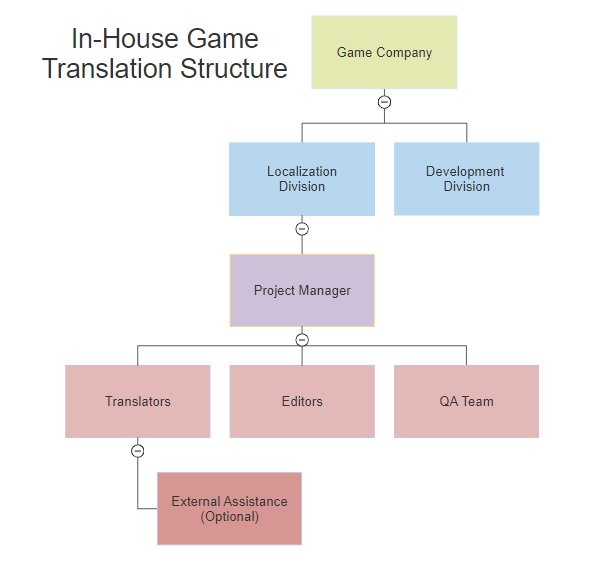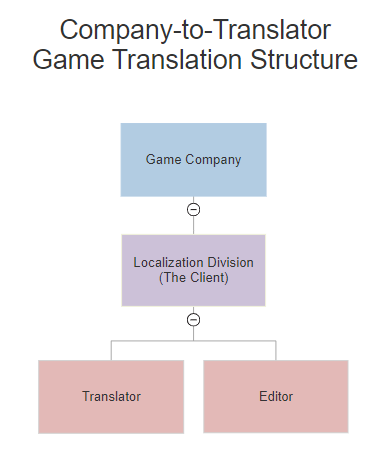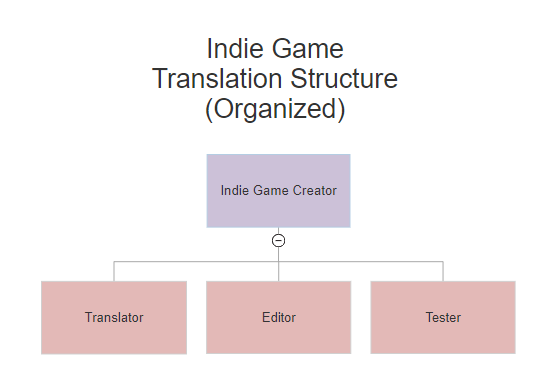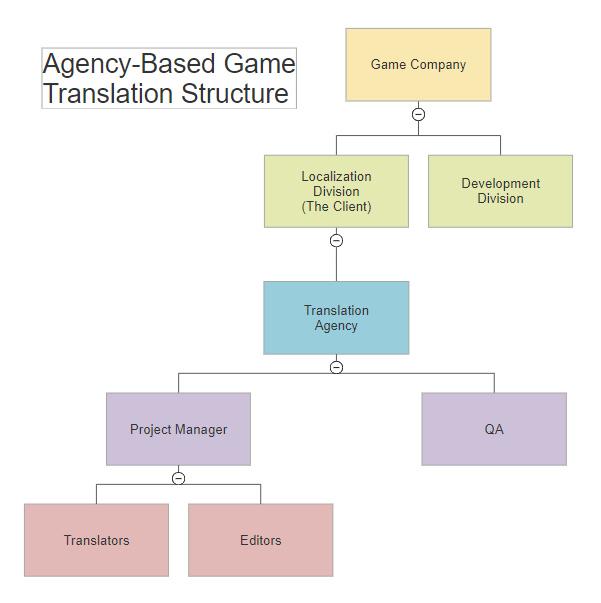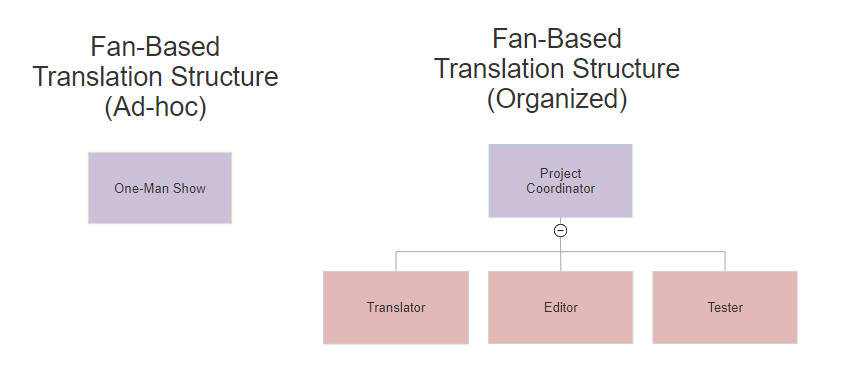Have you ever wondered what the translation process looks like, or how many people are involved? The answer differs heavily depending on genre.
In this thread, I will elaborate on Japanese-to-English game translation structures and processes.
In this thread, I will elaborate on Japanese-to-English game translation structures and processes.
Game translation structures fall into roughly 5 categories:
1) Client in-house translation
2) Client to external translator
3) Indie to translator
4) Client to agency to translator
5) Fan translation
1) Client in-house translation
2) Client to external translator
3) Indie to translator
4) Client to agency to translator
5) Fan translation
In-House Game Translations
Note: This is a BASIC hierarchy tree. Actual ones can vary heavily.
Since this is Japanese-to-English, in-house translations may or may not have to adhere to Japanese corporate structure. Communication with devs is done via project managers.
Note: This is a BASIC hierarchy tree. Actual ones can vary heavily.
Since this is Japanese-to-English, in-house translations may or may not have to adhere to Japanese corporate structure. Communication with devs is done via project managers.
In-house game TL pros:
• QA USUALLY guaranteed
• Ability to do more than one draft of a TL
• Dev support (via PMs)
• No agency dice-rolling
In-house game TL cons:
• Juggling multiple projects
• Communication bottlenecks
• QA USUALLY guaranteed
• Ability to do more than one draft of a TL
• Dev support (via PMs)
• No agency dice-rolling
In-house game TL cons:
• Juggling multiple projects
• Communication bottlenecks
Client to External Translator
This is the basic structure for when a client hires an outside specialist directly instead of doing a project in-house. It& #39;s fairly simplified. Communication is not as tightly restricted as in-house projects.
This is the basic structure for when a client hires an outside specialist directly instead of doing a project in-house. It& #39;s fairly simplified. Communication is not as tightly restricted as in-house projects.
Client to external game translator pros:
• Direct subject matter specialization
• Veteran insights
• Efficient communication structure
Client to external game translator cons:
• High price point for expertise
• No guarantee of speedy turnaround with 1 or 2-man groups
• Direct subject matter specialization
• Veteran insights
• Efficient communication structure
Client to external game translator cons:
• High price point for expertise
• No guarantee of speedy turnaround with 1 or 2-man groups
Indie Game Translations
Indie outfits generally get indie-scale translations, unless they make deals with larger publishers. This squishes the hierachy to 2 layers, where the translator has direct access to the indie dev.
The roles here are fluid as well. Anyone can be QA.
Indie outfits generally get indie-scale translations, unless they make deals with larger publishers. This squishes the hierachy to 2 layers, where the translator has direct access to the indie dev.
The roles here are fluid as well. Anyone can be QA.
Indie game translation pros:
• Direct access to devs/writers
• The simplest QA/test build access by far
• Role flexibility
Indie translation cons:
• Removal of layers means fewer failsafes in place to catch errors
• Direct access to devs/writers
• The simplest QA/test build access by far
• Role flexibility
Indie translation cons:
• Removal of layers means fewer failsafes in place to catch errors
Here& #39;s the big one, agency-based translations.
Once again, QA& #39;s place in this hierarchy can vary. Sometimes the client does it themselves. But this is a 5-layer structure, generally.
For large projects that require extensive tracking, clients tend to prefer hiring agencies.
Once again, QA& #39;s place in this hierarchy can vary. Sometimes the client does it themselves. But this is a 5-layer structure, generally.
For large projects that require extensive tracking, clients tend to prefer hiring agencies.
Agency game translation pros:
• Sophisticated translation management software (MemoQ, Memsource) that helps track TLs across multiple files
• Rolodexes of specialists in various genres
• Able to throw tons of translators at a project when a client really wants that rush job
• Sophisticated translation management software (MemoQ, Memsource) that helps track TLs across multiple files
• Rolodexes of specialists in various genres
• Able to throw tons of translators at a project when a client really wants that rush job
Agency game TL cons:
• Big agencies are black boxes that often don& #39;t credit TLs, so:
You have no idea what you& #39;re getting until you get it
You& #39;ll never know who did it
• More layers = more communication bottlenecks/delays
• More TLs = more potential for errors
• Big agencies are black boxes that often don& #39;t credit TLs, so:
You have no idea what you& #39;re getting until you get it
You& #39;ll never know who did it
• More layers = more communication bottlenecks/delays
• More TLs = more potential for errors
Lastly, I& #39;ll discuss fan translations in two different formats: Organized, and ad-hoc.
Ad-hoc: One person wants to do a thing and takes all the necessary steps to do it on their own.
Organized: Someone spearheads an effort and assembles a team to take all the necessary steps.
Ad-hoc: One person wants to do a thing and takes all the necessary steps to do it on their own.
Organized: Someone spearheads an effort and assembles a team to take all the necessary steps.
Note that the roles in the "Organized" fan TL structure are completely fluid and interchangeable, meaning that anyone can double up as any other part of the process. The structure should be a flat single-layer line (but the software required at least 2 layers).
Fan translation pros:
• No deadlines
• No oversight
• QA optional
Fan translation cons:
• No deadlines
• No oversight
• QA optional
• No dev support
• No feedback regarding translation accuracy
• No failsafes for catching mistranslations
• No deadlines
• No oversight
• QA optional
Fan translation cons:
• No deadlines
• No oversight
• QA optional
• No dev support
• No feedback regarding translation accuracy
• No failsafes for catching mistranslations
When I talk about errors and mistranslations, let me be clear:
EVERYBODY makes errors. That& #39;s why even high-end TL teams usually work in pairs that cross-check each other& #39;s work.
It& #39;s not a question of IF there are errors, but how many, and whether they get caught in time.
EVERYBODY makes errors. That& #39;s why even high-end TL teams usually work in pairs that cross-check each other& #39;s work.
It& #39;s not a question of IF there are errors, but how many, and whether they get caught in time.
This means throwing a large number of translators at a project to rush it out the door is counterproductive for two reasons:
1) Error potential grows exponentially as you get more TLs that aren& #39;t as familiar with the project as the central TLs
2) Less time to catch those errors
1) Error potential grows exponentially as you get more TLs that aren& #39;t as familiar with the project as the central TLs
2) Less time to catch those errors
Also note that most of the time, the translator is on the bottom rung of this hierarchy. Critical decisions about TL choices are generally way above our paygrade and get passed down to us from above. All we can do is abide by our client and/or boss& #39;s instructions.
Anyway, I hope this thread helps to shed some light on the dynamics of different kinds of game translation work. Thanks for reading!
Note: There is a difference between regular QA and LQA (localization QA). LQA is sometimes done by devs and sometimes done by agencies, and that heavily varies. That& #39;s definitely worth distinguishing. https://twitter.com/acelee/status/1241933283144826882">https://twitter.com/acelee/st...

 Read on Twitter
Read on Twitter